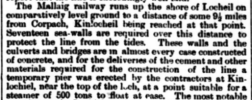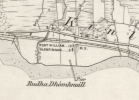Western 52
Established Member
I'm aware of the GWR/WR concrete works at Taunton, which made various concrete components for the railway and for road bridges, etc. Were there other railway concrete works on the other regions? Do any still exist?
There is/was a sleeper production facility at Tallington, north of Peterborough.I'm aware of the GWR/WR concrete works at Taunton, which made various concrete components for the railway and for road bridges, etc. Were there other railway concrete works on the other regions? Do any still exist?
The concrete works opposite the Railway Museum was closed many years ago.The Southern had theirs at Exmouth Junction and the LNER’s was at York.
Thanks, I wasn’t sure if the facility had ever been under the ownership of LNER/BR.Concrete railway sleepers were first made at Tallington next to the East Coast Main Line, but not under railway ownership.
Yes there was the Concrete works at Newton HeathThe Southern had theirs at Exmouth Junction and the LNER’s was at York. I think that the LMS had one at Newton Heath.
AIUI it was not pre-formed sections, but poured as a liquid into shuttered columns on site which then cured.What were the arrangements for constructing the Glenfinnan viaduct
and was mass concrete rather than steel-reinforced, which came later, and would save a lot of the expense of concrete and make structures lighter overall. Wikipedia has a bit about the detail (https://en.wikipedia.org/wiki/Glenfinnan_Viaduct)AIUI it was not pre-formed sections, but poured as a liquid into shuttered columns on site which then cured.
However, when the failing concrete footbridge had to be replaced at Woolston, the planning application details revealed that the Exmouth Junction prefabricated components were of very poor quality, apparently they incorporated ballast straight off local beaches in the concrete, storing up future corrosion problems.The Southern Railway made all sorts of things at Exmouth junction
Fence posts and panels
prefabricated footbridges
lampposts
bridge sections
platform edges and extensions
lineside huts and buildings
I think the flyovers at places like Lewisham and Wimbledon also used prefabricated concrete panels, although in some cases parapets had brick faces added.
Some of the best examples for multiple concrete items are the rebuilt stations where lines were widened. Seaton Junction has (had) lots of concrete parts including a public path footbridge which was very long and spanned whole site

About 1986 give or take a year or so.There is/was a sleeper production facility at Tallington, north of Peterborough.
The concrete works opposite the Railway Museum was closed many years ago.
What were the arrangements for constructing the Glenfinnan viaduct in Scotland in the late 1890s? Presumably all the material used was brought in (by rail, or maybe by boat?) from elsewhere?
AIUI it was not pre-formed sections, but poured as a liquid into shuttered columns on site which then cured.
So, just to ask again, where was the concrete material used at Glenfinnan Viaduct brought in from, and how?and was mass concrete rather than steel-reinforced, which came later, and would save a lot of the expense of concrete and make structures lighter overall.
So, just to ask again, where was the concrete material used at Glenfinnan Viaduct brought in from, and how?
The cement powder presumably by sea, but it is surrounded by hard rock. Wikipedia says ity was too hard to make conventional dressed stone masonry, but they would have had stone from tunnels or cuttings, plus they could quarry nearby.At a guess, by sea to the head of Loch Eli or Loch Ailort and then cart or packhorse; or it could have come by rail to Fort William or the old Banavie and been transhipped. If the line was sufficiently complete they might have brought it in by rail, but I suspect that the viaduct was part complete before the rails reached it.
The S.R. concrete p-way huts are interesting. They have the roof corners clipped so that they could be carried on a lowfit within gauge, and I've seen photos of them being unloaded with an S.R. rail mounted hand crane*.
Intriguing to me that every one you see about - and there are plenty, probably because they're pretty indestructible - was carried by rail all the way from Devon and unloaded on site by a hand crane - sometimes in the middle of a section. Perhaps they set out with a train of them, and dropped them off along a route.
*some may remember the Triang Railways model of this crane.
However, when the failing concrete footbridge had to be replaced at Woolston, the planning application details revealed that the Exmouth Junction prefabricated components were of very poor quality, apparently they incorporated ballast straight off local beaches in the concrete, storing up future corrosion problems.
So, just to ask again, where was the concrete material used at Glenfinnan Viaduct brought in from, and how?
From the Northern Chronicle and General Advertiser for the North of Scotland, 19 September 1900, in an article about the Mallaig Railway subtitled "some interesting facts and figures":A bit of rooting through books fails to provide an answer. However, Thomas’ West Highland Railway did say that a pier was built at Locheilhead and there was presumably already one at Lochailort.
EDIT: The 1899 (survey) 6” map shows a pier at Inverailort that wasn’t there in the 1873 survey. The village may have developed a bit in the meantime as the church at Lochailort was consecrated in 1874.

Thanks for looking. Inverailort is about ten miles from Glenfinnan and, of course, has sea access, so what you suggest is entirely plausible. Loch Eil Head is possibly even closer. Or bulk materials used to build the viaduct could have been brought in by rail via Fort William.A bit of rooting through books fails to provide an answer.

A booklet was produced by Wild Swan in 1987 titled Southern Nouveau an Essay in Concrete.ISBN 0 906867 47 9There's a substantial web page on the Taunton concrete works which made just about everything, including some of the civil engineering structures which not only overwhelmed their little in-house shunter but also the Taunton 08 sometimes sent to assist, and required mainline locos

Taunton Concrete Works
The Taunton Concrete Works was a large user of the railways. Until privatisation the concrete works produced a wide range of products for use on the railways. Fence Posts, Platelayers Huts, Bridge...83b.weebly.com
